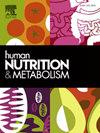Association between ultra-processed foods consumption and systemic immune-inflammation biomarkers in US Adults: Cross-Sectional results from NHANES 2003–2023
IF 1.8
Q3 ENDOCRINOLOGY & METABOLISM
引用次数: 0
Abstract
Background
Limited studies have directly linked ultra-processed foods (UPFs) consumption to immunity. This study investigated the association between UPFs intake and systemic immune-inflammation biomarkers in US adults.
Methods
This cross-sectional study included 34,016 participants from NHANES (2003–2023). Biomarkers related to complete blood cells and high-density lipoprotein (HDL), including systemic immune-inflammation index (SII), systemic inflammation response index (SIRI), neutrophil-to-lymphocyte ratio (NLR), platelet-to-lymphocyte ratio (PLR), lymphocyte-to-monocyte ratio (LMR), neutrophil-to-high-density lipoprotein ratio (NHR), lymphocyte-to-HDL ratio (LHR), monocyte-to-HDL ratio (MHR), and platelet-to-HDL ratio (PHR). The percentage of energy from UPFs (%Kcal) was determined. Weighted linear regression models were used to evaluate the associations between UPFs intake and these biomarkers. Subgroup and sensitivity analyses were also performed to verify the consistency of the results.
Results
The mean %Kcal UPFs was 48.82 % with the standard deviation (SD) of 19.05 %. Crude and adjusted models confirmed positive correlations between UPFs consumption and biomarkers. After adjusting for various confounders, per SD increase in %Kcal UPFs was significantly associated with the increases of 12.595 in SII, 0.027 in SIRI, 0.035 in NLR, 0.148 in NHR, 0.044 in LHR, 5.980 in PHR, and 0.014 in MHR (all P < 0.0001). No significant associations were observed for PLR and LMR. Consistent positive results were found in quartile analysis and sensitivity analyses. Subgroup analysis revealed that alcohol and tobacco use may interact with UPFs intake to affect HDL-based biomarkers.
Conclusions
High UPFs intake was associated with elevated levels of immune-inflammation biomarkers in the general healthy population, highlighting the need to promote natural dietary patterns and reduce UPFs consumption.
美国成人超加工食品消费与全身免疫炎症生物标志物之间的关系:NHANES 2003-2023的横断面结果
有限的研究直接将超加工食品(upf)的消费与免疫力联系起来。本研究调查了美国成年人UPFs摄入量与全身免疫炎症生物标志物之间的关系。方法本横断面研究纳入NHANES(2003-2023)的34,016名参与者。与全血细胞和高密度脂蛋白(HDL)相关的生物标志物,包括全身免疫炎症指数(SII)、全身炎症反应指数(SIRI)、中性粒细胞与淋巴细胞比值(NLR)、血小板与淋巴细胞比值(PLR)、淋巴细胞与单核细胞比值(LMR)、中性粒细胞与高密度脂蛋白比值(NHR)、淋巴细胞与HDL比值(LHR)、单核细胞与HDL比值(MHR)和血小板与HDL比值(PHR)。确定了upf的能量百分比(%Kcal)。使用加权线性回归模型来评估upf摄入量与这些生物标志物之间的关系。还进行了亚组分析和敏感性分析,以验证结果的一致性。结果Kcal upf平均值为48.82%,标准差为19.05%。粗模型和调整后的模型证实了upf消耗与生物标志物之间的正相关。在对各种混杂因素进行调整后,每SD Kcal upf增加与SII增加12.595、SIRI增加0.027、NLR增加0.035、NHR增加0.148、LHR增加0.044、PHR增加5.980、MHR增加0.014显著相关(P <;0.0001)。PLR和LMR没有明显的相关性。在四分位数分析和敏感性分析中发现一致的阳性结果。亚组分析显示,酒精和烟草的使用可能与upf的摄入相互作用,从而影响基于hdl的生物标志物。结论:在一般健康人群中,高UPFs摄入量与免疫炎症生物标志物水平升高有关,这突出了促进自然饮食模式和减少UPFs消耗的必要性。
本文章由计算机程序翻译,如有差异,请以英文原文为准。
求助全文
约1分钟内获得全文
求助全文
来源期刊

Human Nutrition and Metabolism
Agricultural and Biological Sciences-Food Science
CiteScore
1.50
自引率
0.00%
发文量
30
审稿时长
188 days
 求助内容:
求助内容: 应助结果提醒方式:
应助结果提醒方式:


